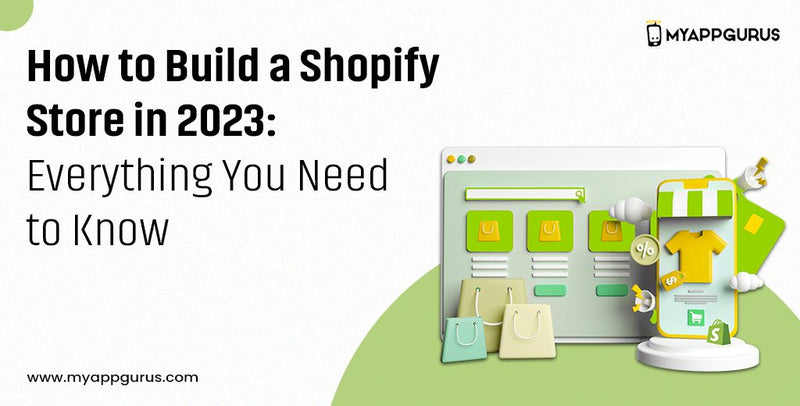How to Build a Shopify Store in 2023: Everything You Need to Know

What is Shopify?
Established in 2006, Shopify is an e-commerce platform ideal for different types of businesses. It is meant for online retailers where business owners can start, grow and manage their business. Since customers can easily reach the store online, the business operates on a global level, allowing business owners to increase their sales and reach all targeted customers without any additional cost.
For merchants and retailers, Shopify builds a multi-channel experience which improves overall brand awareness and makes your business stand out. It is a subscription-based model which comes with a 14-day free trial period wherein merchants can build a website, sell, ship and manage business operations efficiently.
Shopify app development is also equipped with a wide range of tools to analyze different aspects of online stores, maximize ROI, design personalized online experiences and enhance sales and profits.
How Does Shopify Work?
In simple terms, Shopify is an easy-to-use application where merchants can start their businesses and sell products online. It features a point of sale, also known as a POS, application meant for goods payments in physical locations. On Shopify, business owners can run an ecommerce business. Once you have entered into the Shopify application, go to the storefront, add all products that you want to sell, engage with your targeted customers and carry out transactions.
Once the transaction is done, the merchant’s work is done. During this process, the Shopify application helps you throughout different activities as it features several tools that simplify the process. This technology also lowers the cost across the board through inventory management, automating customer relationship management and more.
What to Sell on Shopify?
On Shopify, you can sell a plethora of products from different categories. These include:
- Automotive accessories
- Clothing
- Bags and luggage
- Travel products
- Jewelry
- Home accessories
- Baby or maternity products
- Beauty products
- Kitchenware
- Fitness accessories
- Pet products and more
- Services (appointments)
- Memberships
- Consultations
- Digital products
- Event support
- Experiences
- Classes, lessons, and workshops
- Rentals
- Installations (and quotes)
- Donations
- Event tickets
- Digital gift cards
- Counterfeit goods
- Gambling products
- Certain firearms and their parts
- Adult products
- Regulated products
- Drug paraphernalia
- Event tickets
- Telecommunications equipment
Here are the pros of Shopify:
1. User-friendly
Shopify is a cloud-based e-commerce platform which is known globally for its user-friendly interface, making it a perfect choice for experienced as well as beginner users. This means you can easily set up an online store on Shopify without advanced technical expertise.
2. Mobile friendly
Shopify platform is highly mobile responsive, which promotes round-the-clock operations, allowing targeted customers to check products and services at any point of the day hassle-free. Not only mobile phones, you can explore Shopify stores on various other devices like tablets, smartphones and others.
3. Your domain name
Do you know you can connect your domain name with your Shopify store? It is a major benefit of a Shopify store where you can connect the domain name or buy a domain if you already do not have one.
4. Excellent support
Known for offering round-the-clock support, Shopify is an online platform where you can clear your doubts at any time through emails, messages, live chat, calling and other communication sources. You can also get in touch with community forums and extensive documentation.
5. Excellent themes
Shopify is already equipped with a wide range of themes that shop owners can choose from. On Shopify, you get easy access to more than 70 free and premium ecommerce templates, using which you can build your own website.
6. In-built payment tools
Another major benefit of Shopify is its in-built payment tools. On Shopify, the payment cycle is extremely simple, as customers can make payments using credit cards. It also promotes payments via other sources like Amazon Pay, PayPal, Google Pay, Apple Pay and Cryptocurrency.
Here are the cons of Shopify:
1. Monthly Cost
One of the major cons of Best Shopify Apps is the platform charges a monthly fee that acts like an ongoing expense to your business forever. However, the prices may differ based on the temples, features, tools and other things that you’re using.
2. Transaction fee
Beside the Shopify payments, if you’re using any other payment gateway, you will have to pay an additional transaction fee which acts as business operational cost.
3. Limitations in customization
Although Shopify is regarded as one of the most customizable platforms, there are certain designs, templates or functionalities that you cannot use, especially if you have unique requirements.
4. App and theme cost
Although the platform offers certain plugins and add-ons, certain features and themes require additional cost. With time, these expenses increase that your business will have to bear.
Shopify Statistics 2023
As per 2023 data, there are more than 6,312,392 Shopify stores.
In 2023, there will be nearly 9,200 employees working for Shopify.
In the US, nearly 8.6% of the total e-commerce sales comes from Shopify stores.
How to build a Shopify Store?
Here is the step by step process to build a Shopify store:
1. Sign up for Shopify
Visit the Shopify official website and click on get started. Fill in all required information on Shopify form builder app like your name, firm’s name, email address, password and other details. Tap on click your Shopify store button.
2. Upload your products
Once you have signed in and entered your Shopify store, it’s time to upload your products like clothes, beauty essentials, travel essentials and more. For uploading all products, visit the products section on the Shopify store, tap on the add products section and fill all required information like product description, title, product image, price and discounts.
3. Customize your store
Go to the admin dashboard and search for different templates, logo, theme, color and more. Choose the one that you love. You can also customize the appearance of your theme like fonts, colors and layout so that it matches well with your brand’s face.
4. Setup your domain
If you have an exciting domain, you only have to attach it with your store. In case you do not own a domain, purchase a new domain from the Shopify platform and attach it.
5. Activate the payment cycle
On the dashboard, you will see the payment tab wherein you can choose from different payment options. For no added cost and easy operations, choose Shopify’s payment processor. There are several best review app for shopify that you can use.
How much does Shopify cost?
The Shopify price ranges between $5 to $299 on the monthly basis. Here is the complete breakdown of Shopify cost:
|
Plan |
Monthly fee |
Online transaction fee |
In-person transaction fee |
Non-Shopify Payments fee |
| Shopify Starter | $5 per month. |
5% cents. |
5%. |
2%. |
| Shopify | $79 per month. |
2.6% plus 30 cents. |
2.5%. |
1%. |
| Basic | $29 per month. |
2.9% plus 30 cents. |
2.7%. |
2%. |
| Advanced | $299 per month. |
2.4% plus 30 cents. |
2.4%. |
0.5%. |
| Shopify Plus | Quote-based. |
Based on the credit card sales volume. |
Based on the credit card sale volume. |
0.15%. |
FAQs
1. List some businesses that Shopify store prohibits
Here is the complete list of Shopify store which are prohibited:
- Virtual currency services.
- Investment, credit, money or legal services.
- Adult content.
- Telemedicine or telehealth.
- Gambling.
- Drug paraphernalia.
- Cannabis, tobacco, e-cigarettes and online pharmacies.
- Telemarketing.
- Extended warranties.
- Multi Level marketing companies.
- Products that make unverified health claims.
- Fireworks.
There are thousands of products that you can sell on your Shopify store. These include Automotive accessories, Clothing, Bags and luggage, Travel products, Jewellery, Home accessories, Baby or maternity products, Beauty products, Kitchenware, Fitness accessories, Pet products, and more.
3. Is Shopify platform ideal for beginners?
If you’re new to the world of e-commerce and planning to set up a store on the Shopify platform, start with Shopify’s $5-per-month Starter plan to check the status of your business and its operations.
4. What is Shopify used for?
Shopify platform can be used for a variety of reasons. These include building and running an e-commerce business, managing inventories through the event calendar app shopify, accepting debit and credit card payments, shipping products and others.
5. How can I grow my Shopify store?
Here is the step-by-step process to grow your Shopify store:
- Optimize your mobile settings
- Search engine optimization for Shopify
- Create ads for social media
- Add positive reviews about your business
- Promote social media interactions to improve sales
If you’re planning to establish a Shopify store through the Best Shopify Apps, it is a great idea as it ensures complete ease, better sales and enhanced profits. You can either establish it by yourself or take the expert’s help!
